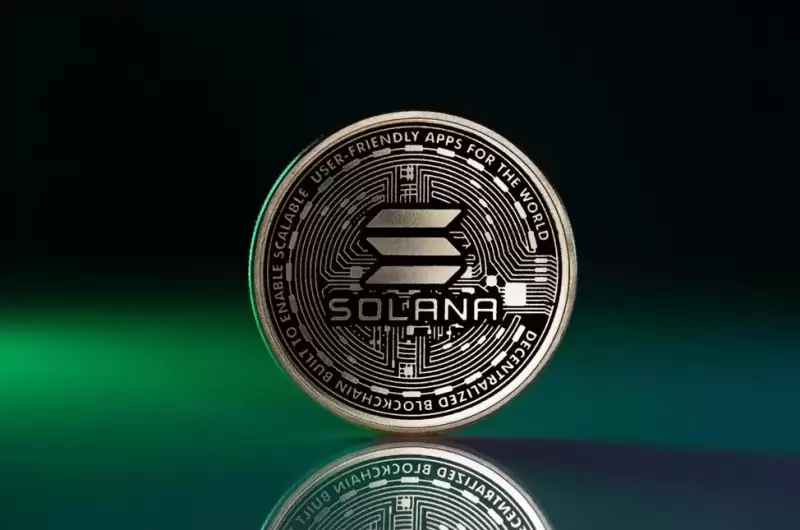 |
|
 |
|
 |
|
 |
|
 |
|
 |
|
 |
|
 |
|
 |
|
 |
|
 |
|
 |
|
 |
|
 |
|
 |
|
截至2025年4月,该基金会实施了一项政策,对于添加到其委派计划(SFDP)的每个新验证者,将删除三个现有验证者

Solana Foundation has adjusted its validator strategy to promote network decentralization and reduce reliance on its support. As of April 2025, the Foundation introduced a policy where, for every new validator added to its Delegation Program (SFDP), three existing validators are removed if they meet specific criteria.
索拉纳基金会(Solana Foundation)调整了其验证策略,以促进网络分散化并减少对其支持的依赖。截至2025年4月,基金会介绍了一项政策,对于添加到其代表团计划(SFDP)的每个新验证者的政策,如果符合特定标准,则将删除三个现有验证者。
This policy, which began with the addition of Blockfolio to the SFDP, will see three existing validators removed. The departing validators are NodeReal, CCVC, and STiC Pay, leaving the SFDP with 15 validators.
该政策从向SFDP添加BlockFolio开始,将看到三个现有验证者删除。离职的验证者是鼻状验证者,CCVC和Stic Pay,使SFDP拥有15个验证器。
To be removed from the program, validators must have been in the SFDP for over 18 months and have less than 1,000 SOL in external stake. Moreover, they must not be a Node as they transition out of the program.
要从该计划中删除,验证者必须在SFDP中持续了18个月以上,并且外部危险中只有不到1,000 SOL。此外,当他们从程序中过渡时,它们一定不能成为节点。
This move aims to encourage validators to attract independent stake and operate self-sufficiently. Concerns have been raised about many validators, in some cases up to 90-100% of their stake, relying heavily on Foundation backing.
此举旨在鼓励验证者吸引独立的股份并自给自足。人们对许多验证者提出了担忧,在某些情况下,其股份的90-100%依赖于基础支持。
Research from Helius indicates that over half of Solana’s validators could become unprofitable without this support, highlighting the challenge of high on-chain governance costs. At present, smaller validators may struggle to maintain profitability and attract independent stake, potentially leading to consolidation or exits.
Helius的研究表明,如果没有这种支持,Solana验证者的一半以上可能会变得无利可图,从而强调了高链治理成本的挑战。目前,较小的验证者可能难以维持盈利能力并吸引独立的股份,可能导致合并或退出。
The policy is part of a broader effort to improve the Nakamoto Coefficient, a measure of decentralization, by reducing stake concentration. However, the Foundation has not yet responded to ongoing discussions about the policy’s impact.
该政策是通过降低损失浓度来改善中心化的中心化量度的更广泛努力的一部分。但是,该基金会尚未回应有关该政策影响的持续讨论。
By prioritizing validators with independent stake and phasing out those overly reliant on Foundation support, the policy aims to improve the Nakomoti Coefficient, reducing the risk of centralized control and enhancing network resilience.
通过使用独立股份的验证者优先考虑验证者,并淘汰那些过于依赖基础支持的验证者,该政策旨在提高Nakomoti系数,从而降低集中控制和增强网络弹性的风险。
Smaller validators, defined as those with less than 1,000 SOL in external stake, will be removed from the program after 18 months, which could render many unprofitable.
较小的验证者(被定义为外部木桩少于1,000的验证者)将在18个月后从该计划中删除,这可能会使许多人无利可图。
With over half of validators potentially unviable without Foundation backing, according to Helius data, smaller validators may struggle to attract independent stake, leading to consolidation or exits.
根据Helius数据的数据,由于超过一半的验证者在没有基础支持的情况下可能无法可行,因此较小的验证者可能难以吸引独立的股份,从而导致合并或退出。
This policy change is part of a broader shift in cryptocurrency toward on-chain governance, where token holders vote on network policies and upgrades.
这一政策变化是加密货币向链链政府进行更广泛转变的一部分,在该治理中,令牌持有人对网络政策和升级进行投票。
Cardano introduced on-chain governance with the Chang hard fork in September 2024, establishing a model with separate governance branches, a legislative body, and a constitutional committee. ADA holders can delegate voting power to Delegate Representatives (DReps), who influence network decisions, including validator (stake pool) policies.
Cardano于2024年9月与Chang Hard Fork一起引入了链政治,建立了一个单独的治理分支机构,一个立法机构和宪法委员会的模型。 ADA持有人可以将投票权委派给代表(DREPS),后者影响网络决策,包括验证者(股份池)政策。
Cardano’s stake pools are community-operated, with rewards tied to delegation from ADA holders. The governance model encourages decentralization by allowing token holders to choose stake pools, reducing reliance on centralized entities.
Cardano的股份池是社区经营的,奖励与Ada Holders的代表团相关。治理模型通过允许令牌持有人选择股份池,从而减少对集中实体的依赖来鼓励权力下放。
Unlike Solana’s Foundation-driven staking, Cardano’s approach empowers the community to incentivize validators through delegation, fostering a competitive validator ecosystem.
与Solana的基础驱动的Staking不同,Cardano的方法使社区能够通过授权来激励验证者,从而促进竞争性验证器生态系统。
This democratic model enhances decentralization but risks low voter turnout, potentially concentrating influence among active DReps or large ADA holders. Compared to Solana, Cardano’s governance is less centralized, as it lacks a foundation dictating validator inclusion, but it faces challenges in ensuring broad participation.
这种民主模式增强了权力下放,但风险冒着低选民的投票率,可能会在主动DREP或大型ADA持有人之间进行积极影响。与Solana相比,Cardano的治理较少集中,因为它缺乏基础决定验证者的包容性,但在确保广泛参与方面面临挑战。
Polkadot’s OpenGov model, implemented in 2023, uses on-chain governance where proposals are written in code, voted on transparently, and executed automatically upon approval. Token holders vote on network upgrades and validator policies, increasing trust through deterministic processes.
Polkadot的OpenGov模型于2023年实施,该模型使用了链上治理,其中提案用代码编写,透明地投票并在批准后自动执行。令牌持有者对网络升级和验证者政策进行投票,通过确定性流程提高信任。
Validators in Polkadot are selected based on stake and performance, with nominators (token holders) choosing validators to back. The system incentivizes validators to attract independent stake, similar to Solana’s push for self-sufficiency. However, Polkadot’s governance is fully on-chain, contrasting with Solana’s off-chain Foundation-led decisions.
Polkadot中的验证者是根据危险和绩效选择的,而提名人(令牌持有人)选择验证器返回。该系统激励验证者吸引独立的股份,类似于Solana的自给自足。但是,Polkadot的治理是完全链的,与Solana的非链基础主导的决定形成鲜明对比。
Polkadot’s transparent, community-driven model reduces centralized control compared to Solana’s Foundation policy. However, it requires active community participation, and “whale” token holders could dominate voting, mirroring Solana’s concern about stake concentration. Polkadot’s approach offers a more decentralized alternative but demands robust engagement to avoid governance capture.
与Solana的基础政策相比,Polkadot透明的社区驱动模型减少了集中控制。但是,它需要积极的社区参与,“鲸鱼”代币持有人可以主导投票,这反映了Solana对股份集中的关注。 Polkadot的方法提供了一种更加分散的替代方案,但要求强大的参与以避免治理捕获。
Ethereum relies on off-chain governance through Ethereum Improvement Proposals (EIPs), discussed in forums, conferences, and GitHub. Core developers, node operators, and miners (pre-Merge) or validators (post-Merge) reach consensus informally, with no formal on-chain voting.
以太坊通过以太坊改善建议(EIPS)(在论坛,会议和Github)中讨论的以太坊改善建议(EIPS)依赖于链政府。核心开发人员,节点运营商和矿工(合并前)或验证者(合并后)非正式地达成共识,没有正式的链投票。
Since transitioning to Proof-of-Stake in 2022, Ethereum’s validators stake 32 ETH to participate, with rewards tied to performance. Unlike Solana’s Foundation staking, Ethereum has no central entity allocating stake; validators compete for community-driven delegation.
自从2022年过渡到股份证明以来,以太坊的验证者32 ETH参加了参与,并与绩效相关。与Solana的基金会不同,以太坊没有中央实体分配股份。验证者争夺社区驱动的代表团。
The ecosystem encourages decentralization through protocols like Lido, though concerns persist about Lido’s dominance (controlling ~30% of staked ETH). Ethereum’s decentralized validator model avoids Solana’s centralized Foundation control but faces risks of stake concentration in large staking pools. Its off-chain governance allows flexibility but can be slow and contentious, as
生态系统通过Lido等方案鼓励权力下放,尽管担心Lido的主导地位(控制了约30%的Staked ETH)。以太坊的分散验证器模型避免了Solana的集中基础控制,但面临着大型堆叠池中股权浓度的风险。它的离链治理可以灵活,但可能会缓慢而有争议,因为
免责声明:info@kdj.com
所提供的信息并非交易建议。根据本文提供的信息进行的任何投资,kdj.com不承担任何责任。加密货币具有高波动性,强烈建议您深入研究后,谨慎投资!
如您认为本网站上使用的内容侵犯了您的版权,请立即联系我们(info@kdj.com),我们将及时删除。
-

- Google搜索比特币现已跌至多个月低点
- 2025-04-28 17:35:14
- 在12个月的时间范围内,此特定搜索词的分数跌至28个,这是自2024年10月以来的最低水平。
-

- 政府持有所有比特币的2.3%,美国,英国和中国领先。
- 2025-04-28 17:35:14
- 虽然有些人积累了更多的BTC,但其他人则像美国和德国一样削减了削减。
-

-

-

- 加密鲸鱼最近决定在比特币和以太坊中ho积1.1亿美元,使更广泛的加密货币市场震撼了
- 2025-04-28 17:25:13
- 标题:加密鲸鱼在比特币和以太信号上大量赌注向前
-

-

- 比特币优势正在通过熟悉的模式进行,下一个目标可能为66%
- 2025-04-28 17:20:16
- 目前,交易者正在观看的最大事情之一就是比特币的主导地位,以及它如何通过一些非常熟悉的模式进行。
-

-

























































